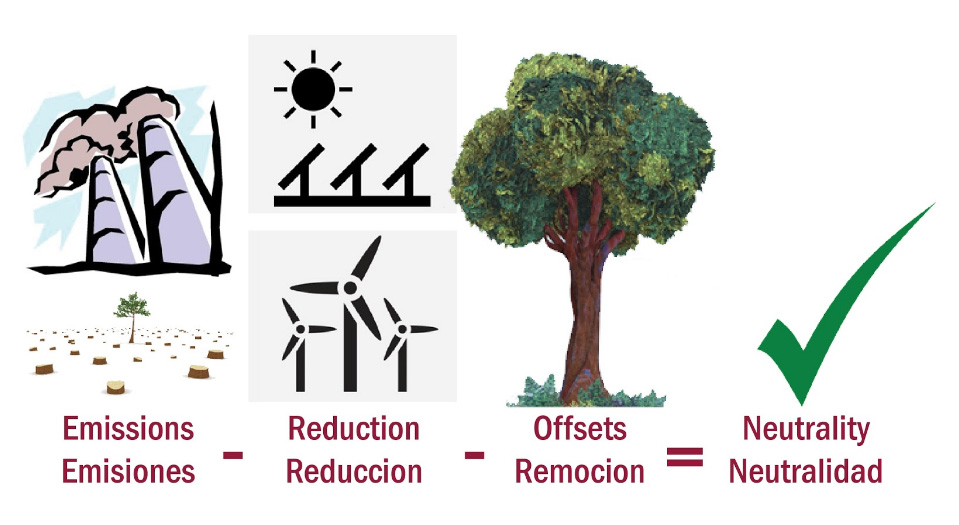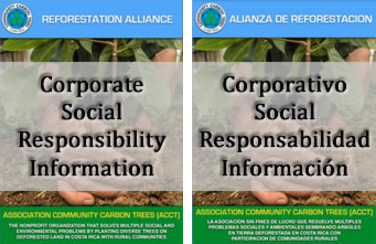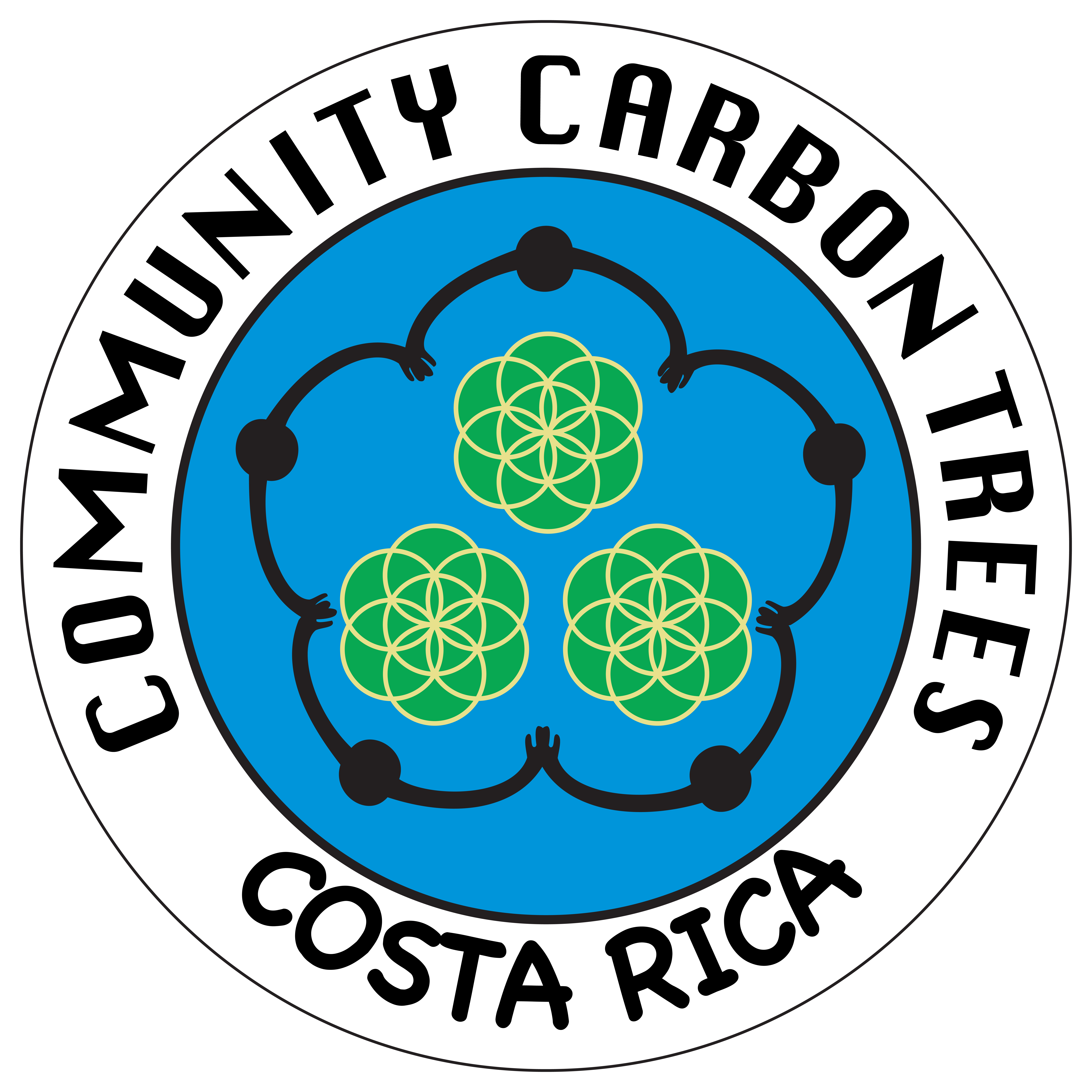

Carbon Offset Program
- What is a Carbon Footprint?
- How to Reduce Carbon Footprint
- What is a Carbon Offset?
- Carbon Offset Program
- Why is this one of the best carbon offsetting programs?
- Where Your Money Goes
- Calculating How Much Carbon Dioxide is Captured by Any Tree.
- Sources of Carbon Dioxide
- Which Countries Produce The Most Greenhouse Gas Emissions?
- Carbon Offsets for Airtravel
- Corporate Carbon Offset: Jones Snowboards
What is a Carbon Footprint?
A carbon footprint is the total amount of greenhouse gases produced directly or indirectly by human activities. Greenhouse gasses are commonly expressed as carbon dioxide.
Individual carbon footprints can be easily calculated. Our handy carbon footprint calculator will compute the tons of carbon used for home and transport per year.
Corporate carbon footprints are calculated similarly. All processes are evaluated in detail to determine total energy consumption of gathering materials, production, distribution, and business operation.
How to Reduce Carbon Footprint
Both businesses and individuals can reduce their carbon footprint and become carbon neutral. Here is the process:
- Calculate carbon footprint. Use our handy carbon footprint calculator for individual footprint calculation.
- Reduce unnecessary consumption of energy and materials. What carbon consumption can we simply eliminate? Things like turning off lights, driving less, taking more direct routes, and buying local products eliminate unnecessary carbon consumption.
- Create energy efficiency. What processes can be made more efficient to reduce the amount of energy needed? Upgrade to LED lightbulbs, install passive solar hot water heaters, retrofit offices with more insulation, double-pane windows, and produce more efficient products/services.
- Carbon Offset. Once processes are streamlined and efficient the remaining carbon emissions should be offset. This is achieved by planting trees with ACCT!
What is a Carbon Offset?
A carbon offset is when carbon credits are used by individuals and businesses to compensate for their carbon emissions. Purchasing carbon offsets is often done with goals of going carbon neutral or carbon negative, producing a low-carbon economy.
Community Carbon Trees plants 1 tropical tree to offset 1 ton of carbon for $25. Click here to plant a tropical tree. Read our holistic approach for how to reduce carbon footprint by carbon offsetting.
Carbon Offset Program
You and your business can offset carbon emissions through ACCT rainforest tree reforestation projects. Each payment of $25 offsets one ton of carbon dioxide.
We support businesses and organizations to calculate the carbon footprint of office operations, product life cycle (packaging, electricity, transportation), and travel. Individuals are encouraged to calculate carbon footprints of travel, their household and other affairs of modern living.
Transparency is king. Clearly communicate your carbon offset process. Include as many details as possible. Explain how you calculate carbon emissions, reduce carbon emissions, and offset all or some of the remaining. Set goals to cap and reduce your businesses carbon emissions over time! Explain how your product or organization is protecting the planet for future generations by offsetting with ACCT and make it part of your marketing strategy.
Set your own level of carbon neutrality. Everyone is spewing carbon into the atmosphere and effectively offsetting carbon today is the wild west. Every carbon offset business strategy will be unique. With demand for corporate social responsibility rapidly growing, the first to evaluate, reduce and offset carbon will be leaders for others to follow.
Click the english or spanish PDF below to read more information about Corporate Social Responsibility with ACCT.
Learn how our reforestation projects works and read below for how we calculate our carbon offsets.
Why is this one of the best carbon offsetting programs?
Each tree must be lovingly tended to in order to grow to maturity, especially for the first four years. Trees must become established and grow up over tall cattle grasses. After 25 years of care and maintenance, a biodiverse forest canopy is formed to give us maximum environmental, economic, and social benefits.
The majority of money from each $25 tree pays a community workforce to care for and maintain trees. Trees reach maturity in 25 years, with the first 4 years being the critical period of establishment. Tree maintenance occurs 3-4 times per year the first 2 years, and 2 times during the 3rd and 4th years. We replace any tree that dies in the first 4 years.
We empower local farmers to work on their own land, which means less deforestation and more reforestation! By creating local jobs, ACCT cultivates greater opportunities for the long-term protection and regeneration of rainforests. Social justice plays a huge role in keeping rainforests standing for future generations. Building value added rainforest products with communities creates a stable economy. And a stable economy protects the environment!
Where Your Money Goes
View our item-by-item account of where $25 goes to planting a diverse, tropical tree!
Calculating How Much Carbon Dioxide is Captured by Any Tree.
It depends on the growth characteristics of the tree species, the conditions for growth where the tree is planted, and the density of the tree's wood. How big and hard does the tree grow over time? Where is the tree located and how old is it? Carbon offset is greatest within 10 degrees of the equator and in the younger stages of tree growth, between 20 to 50 years. Our long term, paid community farmer rainforest management and conservation program is critical to real success. View the infographic in our climate change solution knowledge base section for a biomass calculation visual.
- Determine the total (green) weight of the tree by "W" = Above-ground weight of the tree in pounds, "D" = Diameter of the trunk in inches and "H" = Height of the tree in feet. (1)
- Determine the dry weight of the tree. This is based on extensive publications with tables for average weights for one cord of wood for different temperate and tropical tree species. Taking all species in the table into account, the average tree is 72.5% dry matter and 27.5% moisture.Therefore, to determine the dry weight of the tree, multiply the weight of the tree by 72.5%.
- Determine the weight of carbon in the tree. The average carbon content is generally 50% of the tree's total volume. Therefore multiply the dry weight of the tree by 50%.
- Determine the weight of carbon dioxide sequestered in the tree. CO2 is composed of one molecule of Carbon and 2 molecules of Oxygen. The atomic weight of Carbon is 12.001115. The atomic weight of Oxygen is 15.9994. The weight of CO2 is C+2*O=43.999915. The ratio of CO2 to C is 43.999915/12.001115=3.6663. Therefore, to determine the weight of carbon dioxide sequestered in the tree, multiply the weight of carbon in the tree by 3.6663.6.
- Determine the weight of CO2 sequestered in the tree per year. To do this, we divide the weight of carbon dioxide sequestered in the tree by the age of the tree.
Check out this blog post for an example.
Alternatively, one could calculate that for every 25 trees planted and well managed, you could sequester one ton of CO2 annually.
The favorite metric is for each tree planted, over the life of the tree, 1 ton of carbon dioxide is sequestered from the atmosphere.
The calculation is straightforward: total tree weight is determined by multiplying volume projections by the specific gravity of the wood, with CO2 making up 48% of the corresponding dry weight.
Since ACCT plants a fully biodiverse reforestation project with more than 50 species of trees, including leguminous species and biomass regeneration which further captures carbon dioxide, the projections of one ton per tree will be far outweighed over time. Secondary regeneration in the form of pioneering species also take the excess carbon out of the atmosphere and plant it back into the soil where it can complete the life cycle of trees.
Do you have any idea of the amount of CO2 produced from common activities?
How much carbon is produced to provide energy for our lifestyles?
Sources of Carbon Dioxide
Gasoline
Each gallon of gasoline creates 19 pounds of CO2. People create an average of 5 tons of carbon per year for every car operated.
Electricity
Every kilowatt hour adds 1.7 pounds of CO2 into the air. On average, each home in the US consumes 840 kWh per month (EPA, Region 1 North East), which adds up to 5.5 tons of yearly CO2 production.
The following figure shows just how much carbon dioxide is released into the atmosphere when we burn fossil fuels and other combustibles to provide energy to support our lifestyles and businesses:
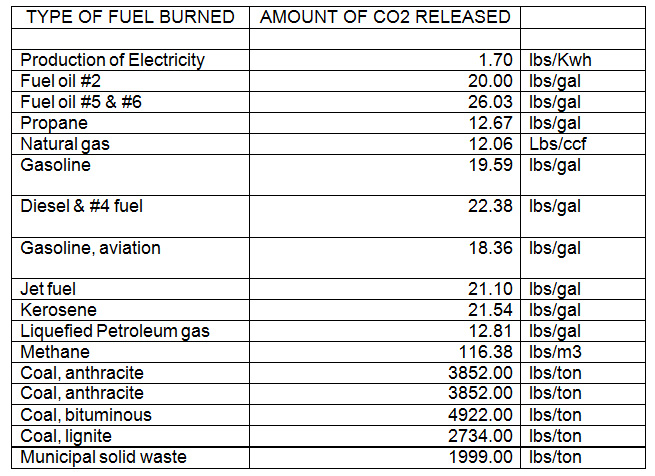
* Data provided by P J Horgan, Energy Systems Mgr., Connecticut College, 12/10/97. Source for the above list: US Dept. of Energy, Form EIA-1605 (1998)
Did you know that the United States is the highest average producer of carbon dioxide in the world?
Which Countries Produce The Most Greenhouse Gas Emissions?
China is the largest emitter of carbon dioxide. The United States is the largest carbon dioxide emitter per person or per capita. This is due to the large population size of China compared to the United States. So on average, one person in the USA produces much more carbon than one person in china.
As shown in the chart below, in 2011 the top carbon dioxide (CO2) emitters were (in order from greatest to least) China, the United States, the European Union, India, the Russian Federation, Japan, and Canada. This data includes CO2 emissions from fossil fuel combustion, as well as cement manufacturing and gas flaring. Together, these sources represent a large proportion of total global CO2 emissions.
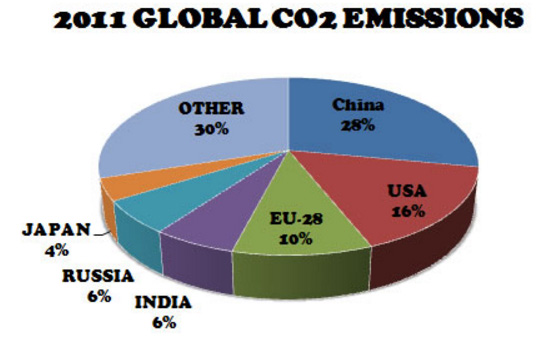
Chart source EPA global greenhouse gas emissions.
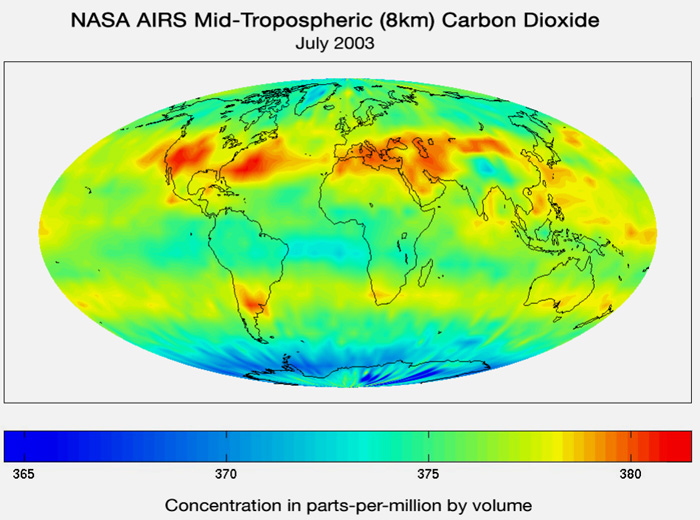
How many trees should I plant to offset my CO2 emissions?
Carbon Offsets for Airtravel
This chart lists the airplane carbon emissions per person for various destinations and how many trees must be planted to offset the carbon of air travel.
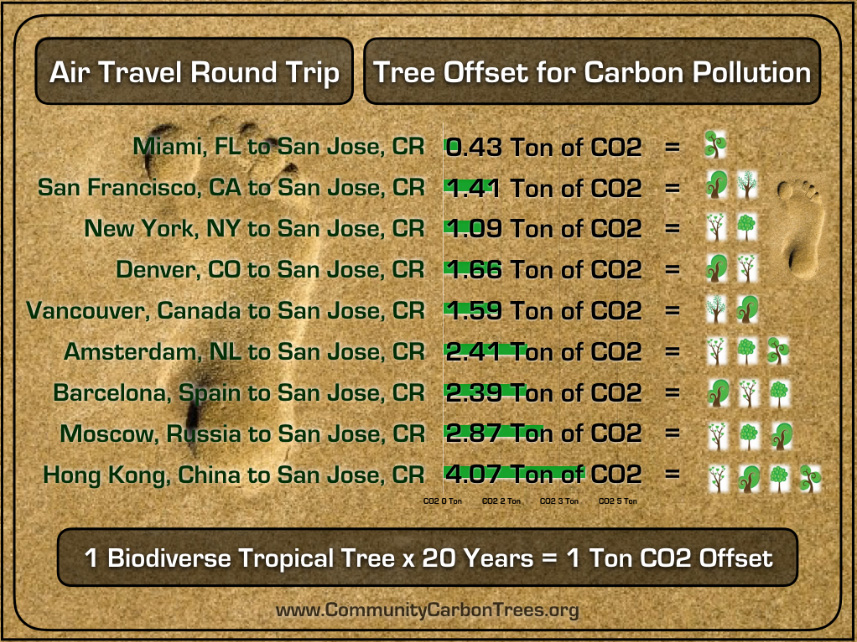
The "How Big is Aviation's Emissions Gap?" chart below shows 7.8 billion tons of carbon that will be emitted above 2020 levels without additional efficiency and technological improvements for carbon reductions. Projected operational improvements are shown in light blue.

Corporate Carbon Offset: Jones Snowboards

In May 2014 Jeremy Jones and his family traveled to Costa Rica and volunteered for the non-profit rainforest reforestation Association Community Carbon Trees (ACCT). Jeremy and his family helped Jennifer and the CCT crew collect tree seeds, plant saplings and prepare land for future reforestation. Witnessing ACCT's efforts and connection with the community was a game changer for Jeremy.
"I've searched for years for a rainforest program to support," said Jeremy Jones. "I found it with ACCT. Jennifer takes real action for the environment and the local people love her. She brings them work and reforests their land in a way that they can make a living off maintaining the forests."
"Rainforest reforestation happens one tree at a time. Jeremy and his family got involved with the effort collecting seeds, planting saplings and preparing ground while volunteering with Jennifer Smith of Community Carbon Trees in Costa Rica."
-Jeremy Jones
Jones Snowboards has planted 400 trees with ACCT in 2015 all growing well on FINCA ECo Chontales in Costa Rica, Valley San Juan de Dios. Jones Snowboards is committed to being an outdoor industry leader in the fight against climate change. Building snowboards will always have an environmental footprint so we strive to minimize this footprint whenever possible by developing new eco-tech and supporting organizations that fight against climate change on the front lines. We take these efforts seriously because we care about how our actions will affect the environment for future generations. Read more here.







